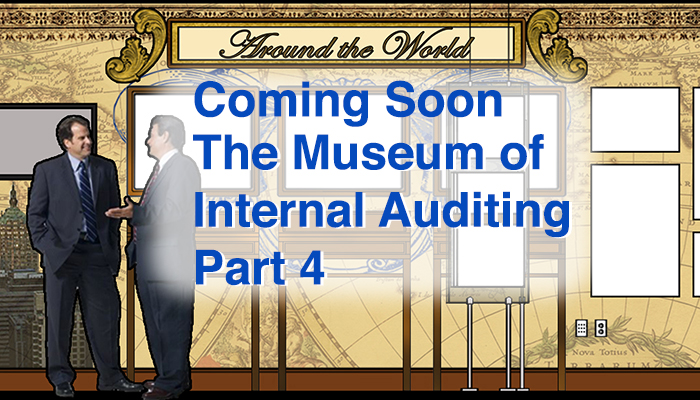Designs – Finding the Physical form
This is the fourth article in a series about designing and building the Museum of Internal Auditing in eight months. The previous article covered our design kickoff meeting and how it helped refine our narrative. This article explores our design process and how we started defining the physical space.
Design is a process and designing museum exhibits can be complicated. There are many disciplines that are working together and solving similar or parallel design problems. We have to watch out for issues from one discipline that can affect others. The task is to keep all of these disciplines moving forward in a way that supports the designs as a whole.
The biggest challenge that we have with this museum gallery is its size. We need to do a credible job of representing the history, challenges, and impact of a profession with more than 180,000 members, more than 190 chapters, and thousands of years of history in just 475 square feet of space. We also want to spend as much time as we can talking about how the members of this profession affect all of our lives. And of course, the exhibits need to be informative and engaging.
We initially tried to tell the story in a linear way and we kept running out of room before we could get to the most important message. The length of the time scale meant that we were spending too much time on the background information leaving very little time and space to devote to what is most important which is how much of our daily lives is impacted by the work that members of this organization perform. Our solution included compressing the beginning of the time line into an interactive activity that makes a lot of information available to the guests and encourages them to explore thousands of years of history in a very small area.

There are 24 information panels in this interactive. Each panel has two sides and is built so that the guest can spin the panel to reveal either side. That gave us 48 information panels which will cover a large portion of the time line. Presenting the information in this way is less intimidating to guests because only half of the information is visible at any given time. One other feature of this exhibit is that guests will see new information every time they visit the museum. It should never exist in exactly the same configuration. Returning guests will see something different every time they visit.

We also designed sliding panels that will cover 5 areas of the historical record in more detail. These sliding panels offer a unique opportunity for storytelling. The copy is written in three parts, but the guests will not read them in any particular order. Each part has to be able to stand alone if guests read only one panel before they move on. For guests who will read all of the panel, they will experience three parts of the same story that guests will read in their own order.

Next we designed an area devoted to the Institute of Internal Auditors. It is another small area that covers a very important part of the story. The exhibit is built around the original founding documents for the institute. The document represents an important shift in the profession of internal auditing. The signing of this document transformed the profession of internal auditing. We designed a custom artifact case to highlight this transformational event. The rest of this area uses additional artifact cases and a touchscreen monitor to show how the IIA as an organization helped to develop the profession of Internal Auditing.

The IIA is an international association that periodically hosts representatives and delegations from chapters all over the world. We added an area with artifact cases and wall cases for them to highlight work being done and the history of these chapters. These are intended to be changed quarterly or as the need arises.
The remaining space is dedicated to highlighting the work that members of the association are doing and how that work is having a positive impact on all our lives. There are a total of 54 graphic panels that will each feature an individual internal auditor, the work that they are doing or that they did, and how that positively affects our lives. The intention is not that guests will read all of the panels, but rather get a sense of just how much work these individuals are doing on our behalf.

The work that internal auditors do is not always apparent to us. Standing in this part of the gallery, surrounded by the faces and stories of all these individuals, guests will start to understand how internal auditing affects their daily lives and connect with some of the internal auditors that are working on their behalf.
This is the fourth post in a multi-part article about the process of designing and building the Museum of Internal Auditing in only eight months. In the next article, we will explore the research and writing that goes into developing exhibits like this. If you want to read more about this process, you can use the following links:
Building a Museum in Eight Months – Part 1
Building a Museum in Eight Months – Part 2
Building a Museum in Eight Months – Part 3

